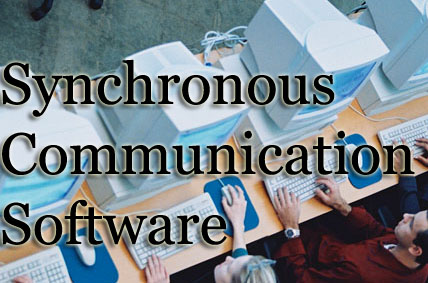
ETAP 529 Introduction to Distance Learning
University at Albany
Professor Virginia Yonkers
Spring 2008
Technology Group 4: Abigail Moskovits, Tom Cutonilli, Anne Canale Stalnecker
 |
ETAP 529 Introduction to Distance Learning Technology Group 4: Abigail Moskovits, Tom Cutonilli, Anne Canale Stalnecker |
|---|---|
| Table of Contents > Introduction > SCS Technologies > Appropriate Uses & Limitations >Support & Costs> References | |
Appropriate Uses & Limitations of Synchronous Communications Software
Appropriate Uses
Sherry's article stresses, "distance education systems now involve a high degree of interactivity between teacher and student, even in rural and isolated communities separated by perhaps thousands of miles." These "distance" situations are the ideal environment for utilizing synchronous software communication tools in an academic exchange; however, the tools are successfully being used in many other ways:
- K-12
- Teachers use IM and Chat as supplemental tools in classrooms in all grade levels, across all disciplines. Used as a communication tool, the software offers parents the opportunity to contact with their children’s teacher to check on progress, ask questions, get homework help, etc.
- EdTechTalk in an online resoursce with streaming video and a live chat session for teaching professional development opportunities.
- Higher Education
- Colleges and universities frequently use IM and Chat technologies as instructional technology help desk support, library research, student advisement services, and even online office hours.
- As a supplement to traditional, blended and asynchronous courses, IM and Chat is used to collaborating in groups/teams.
- Conferences and panel presentations are coordinated via synchronous tools.
- Business/private sector
- The business world frequently uses IM to provide instant sales help (e.g., Hewlett Packard online ordering) and to provide immediate service to their customers and clients.
- Meetings are held online (GoToMeeting), and training seminars and conferences are attended via videoconferencing "webinars" (Horizon Wimba).
Advantages at the university level in the distance education realm are obvious. Students, classmates and professors who are in the same class or group can contact one another at any time of the or night to share ideas, ask questions, brainstorm on projects, and generally provide support for each other. It is human nature to desire human interaction, and synchronous tools can provide the opportunity students need for real-time dialogue in the e-learning environment, thus bridging the divide between impersonal computer-based learning and the human need for feedback and support.
Ruth Reynard provides some excellent tips for using chat as an instructional device. In her article, "Tips for Using Chat as an Instructional Tool," she begins by explaining, "chat software (text or media-based) provides an excellent tool in supporting academic dialog (exchange), critical thinking, and knowledge building. The immediacy of the technology provides students with a direct connection with the instructor as well as other students.” (Reynard 2007) Technology fills the void between the distant uncongenial world of technology with the inviting and warm world that is needed to develop a productive environment for education.Limitations
IM and Chat tools, while beneficial in many respects, do have a number of limitations. These tools may not be suited well for specific disciplines and courses such as teaching a foreign language or teaching algebra. Sherry reports that foreign language instruction presents special instructional challenges because of the loss of visual detail required in mastering another language (Sherry 1997). Mastering the algebraic functions in a chat or IM would also be quite difficult.These tools also present a dangerous aspect. The Internet with its anonymity invites predators and "cyberbullies" to prey on children. Parents/educators must be vigilant watching over their children/students when using these tools, for if given the opportunity, curious children may be baited into dangerous territory. (See Be Safe Online: Bullying Online and Cyberbullying tragedy.)
The technology itself may also present problems. As simple as IM and chat may appear to be very user-friendly, but some may be novices in the technology field and may need extra training to use these tools effectively. Usability (the effectiveness, efficiency, and satisfaction with which users can achieve tasks in a particular environment of a product) is yet another issue (dictionary.com).
Most importantly, as educators and instructional designers we need to ensure that the use of these tools is in alignment with learning objectives and that desired student outcomes are a priority. Before taking advantage of these technologies, several questions must be carefully considered:
- Is the tool appropriate for the age group, discipline, content area?
- What are the benefits of this technology? Will they enhance or impede the learning process?
- Will the IM/Chat be used as a structured activity, or for purposes of informal dialogue?
Reynard stresses in her article that it is important to realize, "providing tools to students will not achieve a desired instructional outcome. Reaching a level of instructional success requires effective instructional design and intentional planning on the part of the instructor." (Reynard 2007). The equitable access issue is again present with this technology. The use of these tools requires equal access to all students, which is a recurring educational obstacle.
Next page > Top of Page > Table of Contents
Technology Group 4: Abigail Moskovits, Tom Cutonilli, Anne Canale Stalnecker
ETAP 529 Introduction to Distance Learning
Professor Virginia Yonkers
University at Albany
Spring 2008Updated 02-Mar-2008